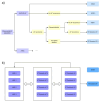An Economic Evaluation of a Streamlined Day-Case Atrial Fibrillation Ablation Protocol and Conventional Cryoballoon Ablation versus Antiarrhythmic Drugs in a UK Paroxysmal Atrial Fibrillation Population
- PMID: 38244143
- PMCID: PMC11058164
- DOI: 10.1007/s41669-023-00471-6
An Economic Evaluation of a Streamlined Day-Case Atrial Fibrillation Ablation Protocol and Conventional Cryoballoon Ablation versus Antiarrhythmic Drugs in a UK Paroxysmal Atrial Fibrillation Population
Abstract
Background and aims: Symptom control for atrial fibrillation can be achieved by catheter ablation or drug therapy. We assessed the cost effectiveness of a novel streamlined atrial fibrillation cryoballoon ablation protocol (AVATAR) compared with optimised antiarrhythmic drug (AAD) therapy and a conventional catheter ablation protocol, from a UK National Health Service (NHS) perspective.
Methods: Data from the AVATAR study were assessed to determine the cost effectiveness of the three protocols in a two-step process. In the first stage, statistical analysis of clinical efficacy outcomes was conducted considering either a three-way comparison (AVATAR vs. conventional ablation vs. optimised AAD therapies) or a two-way comparison (pooled ablation protocol data vs. optimised AAD therapies). In the second stage, models assessed the cost effectiveness of the protocols. Costs and some of the clinical inputs in the models were derived from within-trial cost analysis and published literature. The remaining inputs were derived from clinical experts.
Results: No significant differences between the ablation protocols were found for any of the clinical outcomes used in the model. Results of a within-trial cost analysis show that AVATAR is cost-saving (£1279 per patient) compared with the conventional ablation protocol. When compared with optimised AAD therapies, AVATAR (pooled conventional and AVATAR ablation protocols efficacy) was found to be more costly while offering improved clinical benefits. Over a lifetime time horizon, the incremental cost-effectiveness ratio of AVATAR was estimated as £21,046 per quality-adjusted life-year gained (95% credible interval £7086-£71,718).
Conclusions: The AVATAR streamlined protocol is likely to be a cost-effective option versus both conventional ablation and optimised AAD therapy in the UK NHS healthcare setting.
© 2024. The Author(s).
Conflict of interest statement
Joe Moss, Lukasz Grodzicki, Beatrice Palazzolo, Richard Mattock, Stuart Mealing, Tom Bromilow, and Damian Lewis were employees of York Health Economics Consortium (YHEC) at the time of this study. YHEC received payment from Medtronic, manufacturer of the Arctic Front Advance Cryoballoon, to conduct the cost-effectiveness analyses and to write the manuscript. Derick Todd and Prapa Kanagaratnam have received personal speaking fees from Medtronic in the past. Maxim Souter, Benedict Brown and Eleni Ismyrloglou were employees of Medtronic at the time of this study. Benedict Brown and Eleni Ismyrloglou also declare holding stock and stock options in Medtronic. James McCready has received personal speaking and consulting fees from Medtronic in the past. Muzahir Tayebjee has previously received a research grant from Medtronic. Ewen Shepherd has previously received honoraria for lectures from Medtronic. Thiagarajah Sasikaran, Clare Coyle and Nicholas A. Johnson have no conflicts of interest to declare.
Figures


References
-
- National Clinical Guideline Centre. Atrial fibrillation: diagnosis and management. 2021. https://www.nice.org.uk/guidance/ng196.
-
- Kanagaratnam P, McCready J, Tayebjee M, Shepherd E, Sasikaran T, Todd D, et al. Ablation versus anti-arrhythmic therapy for reducing all hospital episodes from recurrent atrial fibrillation: a prospective, randomized, multi-centre, open label trial. EP Europace. 2023;25(3):83–872. doi: 10.1093/europace/euac253. - DOI - PMC - PubMed
-
- National Institute for Health and Care Excellence. NICE health technology evaluations: the manual. 2022. https://www.nice.org.uk/process/pmg36.
Grants and funding
LinkOut - more resources
Full Text Sources

